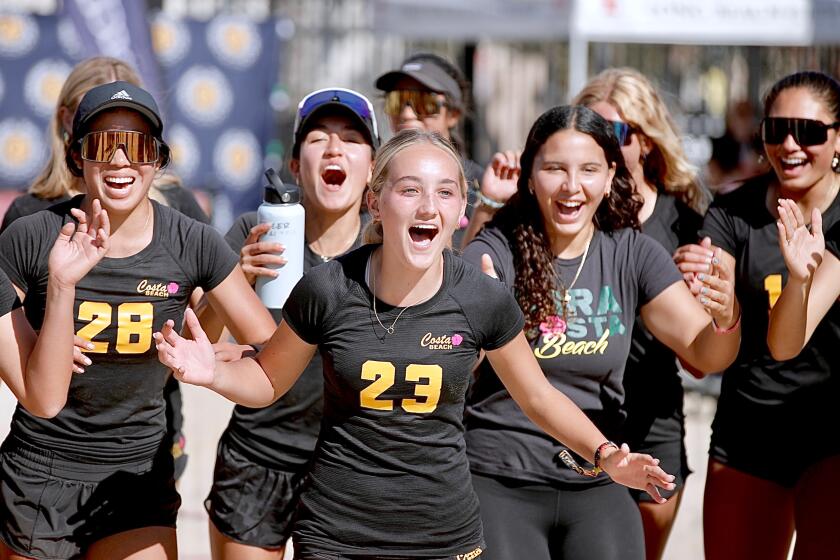Division II Coaches Can Only Count the Reasons Why Basketball Players Leave
- Share via
When freshman Marty Ward quit the Cal State Dominguez Hills basketball team two days before Thanksgiving, it left Coach Dave Yanai without the power forward he thought his team needed to be a contender in the California Collegiate Athletic Assn.
Not that the 6-foot-5 Ward, who left for religious reasons, was considered the greatest gift to the Toros’ basketball program. But his rebounding was expected to complement three returning starters.
Sudden departures like that of Ward, who left two games into the season, are not uncommon in the CCAA and at other Division II colleges, coaches say.
“Lots of kids on this level . . . say ‘to heck with it’ and quit,” said UC Riverside Coach John Masi.
Looking around the CCAA as the 1988-89 season began: Cal State Los Angeles lost seven players from its previous roster; Cal Poly Pomona five, including two who surrendered scholarships; UC Riverside four and Cal State Northridge two, both on scholarships. Cal State Bakersfield, last year’s CCAA champion, welcomed back just one of three starters eligible to return. Only Cal Poly San Luis Obispo returned everyone it expected.
The basketball program at Dominguez Hills is considered by coaches to be one of the most fundamentally sound on the Division II level. Still, Ward is one of seven players to quit the program in the last three seasons. And a starter on this year’s team has said he will quit at the end of the season and transfer to a school that has more to offer in his major: physical therapy.
Players have a variety of reasons why they don’t return or quit in mid-season. In the case of Dominguez Hills, two players quit for physical reasons, two for religious reasons, one because marital problems hurt his grades and another because he was not playing. In addition, one player transferred to a Division I program.
Coaches say the Dominguez Hills situation points out the frustrations of recruiting players in Division II.
“If they can’t play for Yanai, then they can’t play for anyone,” said Coach Dave Holmquist of Biola University, an NAIA power considering a jump to Division II.
Division II coaches cite four reasons for their low retention rates:
Lack of prestige. Ward, a Jehovah’s Witness, said his dropping out of school to take up preaching would have been “much more difficult” at a Division I school.
Explained Cal Poly Pomona Coach Dave Bollwinkle: “It’s a lot more difficult to quit the program at, say, Kentucky, and then go home and tell your friends about it, than it is to tell them you quit the team at Cal Poly Pomona.”
Added Coach Henry Dyer of Cal State Los Angeles: “Most kids don’t realize they are Division II players. Most kids would rather be (sitting on the bench) at a Division I school.”
Fewer reasons to play. Small crowds and less news exposure make it easier for bench-warmers to leave.
Said Cal State Northridge assistant Rusty Smith, a former star at El Camino College: “It takes a year or so for (high school) players to come in here and make an impact. They don’t realize how far behind they are. . . . They become disenchanted.”
Others quit, then resurface at other schools. “The kids that jump ship from here to there are kids that usually have had problems,” Yanai said.
With less to play for, basketball can become secondary. Said Holmquist: “As you get older, you tend to be not as excited to play basketball. You decide not to play anymore and to concentrate on other things (like friends and getting a job).”
Less money. At privately funded Chapman College, which is considering a drop to Division III, a scholarship is worth about $14,000 a year. That’s a lot of money, but Cal State Dominguez Hills, in contrast, has less than $12,000 in its recruiting and scholarship budget. Yanai funds only some athletes, and most of the money they receive goes for books and tuition only.
In addition, coaches say, athletes are so busy with basketball and school work that they seldom have a chance for part-time jobs. “We have a situation where . . . they are waiting from one scholarship grant check to the next,” said Yanai. “It’s a plight we are all in at Division II.”
Attitude problems. Division I universities, with larger budgets and better facilities, have more to offer touted athletes. Bollwinkle put it succinctly: “We don’t have the pick of the crop.”
Division II coaches have to be more selective with the leftovers, which, according to Yanai, means taking a player who might be “a little bit flawed. The kids we get, we try to screen very closely because of attitude.”
A lot of athletes make a mistake when they accept a scholarship to a Division I school because they go thinking only about playing basketball, not about getting an education, said Cal State L.A.’s Dyer. “It’s tough to convince the marginal Division I player that he should come here, play some basketball and have some fun.”
It’s not clear how well California schools fare in retaining athletes compared to Division II schools around the country. The NCAA does not keep statistics on Division II dropout rates.
But the NCAA’s most recent survey of nationwide trends in graduation showed that only a third of Division I freshman basketball players finish with a degree. CCAA coaches say their rate of graduation is higher and that this is one of the benefits of playing in Division II, whether an athlete completes his eligibility or not.
“These kids get an opportunity to get an education and participate in one of the great experiences for any young person--intercollegiate athletics,” Yanai said. “That doesn’t come to everyone.”
UC Riverside, rumored to be considering a move up to Division I, has many basketball dropouts continuing their education, according to Masi.
“I have an entire team of former players out there,” he said. “They haven’t quit school, but they decided that basketball was not for them any longer.”
At Cal State Northridge, which will move to Division I in 1990, Smith said it does a program no good if, once an athlete decides to leave, the coach loses contact with him.
“We want to be a help to kids because eventually they will recruit players for you,” he said. “We don’t want them to leave here with a bad taste in their mouths.”
Once it becomes obvious that a player’s future is limited, coaches at Northridge suggest that he play at a community college. Smith said the program and the player can and should part in a friendly way.
Of course, said Yanai, “there are players that are thick-skinned and repel correction. They feel like they are mistake-free. These are kids with good ability but with egos of the extra-large size.”
Yanai says he screens players’ attitudes to see whether they fit into his system of team play and hard work.
“Usually, I recruit on the average one out of six kids that I think would be questionable in attitude. I feel that our other kids are good enough and strong enough as human beings to help that person come around.”
So Yanai is forced to take a chance once in a while on an athlete with potential, rather than recruit a recognized star.
Bollwinkle, an assistant at three Division I schools before coming to Pomona last year, has already felt the dangers of recruiting in Division II.
“Many (players) don’t have the work habits,” he said.
But Bollwinkle also said that on all levels there are unscrupulous coaches who get rid of marginal players when somebody else comes along to take their place.
“There are some guys that have no qualms about pushing kids out of a program,” he said.
Cal State Hayward Coach Gary Hulst, somewhat of a maverick in his methods, has nevertheless made a perennial power out of the Pioneers without having a scholarship to offer.
“The kids we get like to play,” he said. “They last because they like the game.”
And he had a suggestion for his counterparts in Southern California:
“I under-recruit. Basketball is a game of seven or eight guys. Some of these teams have 12-15 players. I owe it to my kids to let them play.”
More to Read
Get our high school sports newsletter
Prep Rally is devoted to the SoCal high school sports experience, bringing you scores, stories and a behind-the-scenes look at what makes prep sports so popular.
You may occasionally receive promotional content from the Los Angeles Times.






